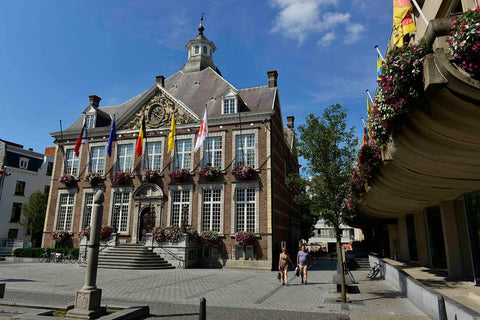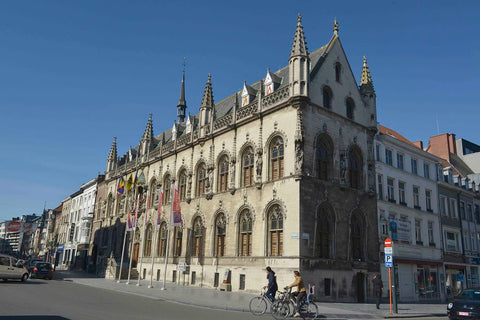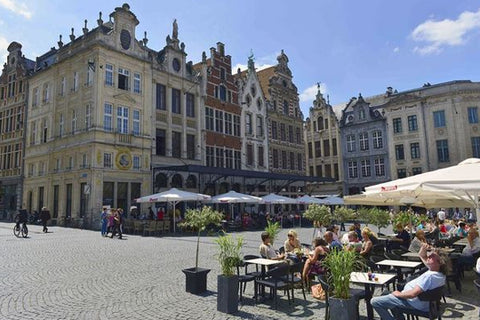- No products in the cart.
Bastogne

Bastogne is one of those quiet little Ardennes towns that would have gone pretty-much unnoticed, if history hadn't intervened so dramatically in the snowy Christmas of 1944. Now it's a town synonymous with the Battle of the Bulge – the epic last gasp of the German Army in the Second World War – and the heroic defence of the town by besieged American soldiers.
And Bastogne won't let you forget those days of American grit and German desperation. The town is heaving with monuments, museums, battle-field memorials and cemeteries, all dedicated to keeping alive the memory of the events of that fortnight in December '44. But Bastogne isn't just about 'the Bulge'. Lying near the border with Luxembourg, in the south-east of Belgium, this French-speaking town sits in the pleasant rolling countryside of the high Ardennes plateau.
The woods, meadows and small valleys of the Wiltz valley are home to boar, bilberries and bison. It's a landscape where the bicycle is king, and where sacred springs bubble with promise of cures for all.
And talking of holy beverages, there's the small matter of beer and a decent smattering of local breweries – including the nearby Brasserie d'Achouffe, which has become a defining beer of the Ardennes, for many.
History

For a town cruising towards such a date with destiny, Bastogne successfully managed to avoid tangling with the history pages for a long time. First mentioned in 634 AD as a small settlement on the Wiltz river, it was passed from the Abbey of St Maximin's to Prüm Abbey in the 8th century.
Documents of the time mention a small town and a marketplace. But wealth did, apparently, come Bastogne's way, thanks to the timber from its forests, and the cattle fairs held here.
By 1332, it was a granted city status by John the Blind, Count of Luxembourg, and built itself an impressive ring of fortifications – including a wall buttressed by fifteen towers and two fortified gates.
Like the rest of Luxembourg, Bastogne passed on to first to the Burgundians, and then the Spanish in 1516. When the Dutch came to try their hand at the city's fortified walls, in 1602, they were sent packing.
The French, however, were more successful, with Louis XIV occupying it as part of the Nine Year War. In 1688, however, the French 'Sun King' ordered the walls pulled down – he didn't want the city's defences aiding his enemies in the 'Grand Alliance', if they retook Bastogne. The town remained a significant trading centre for the eastern Ardennes, though, and grew in importance with the arrival of the railways.
It was, after all, an important transport hub, connecting France, Germany and Luxembourg. And in that connectedness lay the seeds of Bastogne's upcoming date with history..
The Seven Roads to Hell

Viewed from above, the 7 roads leading into (and out of) the town give it the appearance of a dart board... with Bastogne dead-centre in the middle. And Bastogne did indeed become a bulls-eye for one of the fiercest – and most important – battles of the Second World War. The Battle of Bastogne, part of the wider German counter-attack in 1944 known as the Battle of the Bulge, was a ferocious siege between an outnumbered American force and a German force five times its size.
The Battle of the Bulge had its origins in the legend of the impassable terrain of the Ardennes. Just like in 1940, the Allies – who had pushed the Germans back up against the Luxembourg border – decided the Germans couldn't (and wouldn't) attack through its hills and forests. So they stationed only a few divisions in the area. Divisions like the US 28th Infantry Division, which was resting in Bastogne after months of heavy-fighting elsewhere. That assumption proved to be a big mistake, as the German's quietly assembled 50 divisions across the border, which were then unleashed on the 15th of December 1944, for Hitler's last gamble.
Both sides knew that without those 7 roads radiating out from Bastogne, the German plan – to slice through Belgium towards the North Sea – would be held back by choking supply routes. The US commander, rushed in reinforcements, including the 101st Airborne division, to prevent Bastogne from falling.
These were promptly encircled by the advancing panzers, and on December 22, the Germans asked for the Americans to surrender. The reply was brief, succinct and very American. “Nuts!”
In the end the American lines held, but they were surrounded for nearly a week without supplies, fending off repeated attacks along those notorious seven roads. Partly as a result of this ongoing Battle of Bastogne, the broader German attack was slowed and faltered. Rather than reaching the North Sea, the panzers barely made it to the Meuse.
By the 27th of December, the Americans of General Patton's 3rd Army had broken back through to Bastogne, and the German 'bulge' was squeezed back across into Luxembourg. It was the last German offensive of the Second World War, and its failure ensured the doom of Hitler's Third Reich. A pretty big honour for a little Ardennes town, and its gritty American defenders.
Getting There & Getting About

Although sitting quite far from the big cities and towns of Flanders and Wallonia, Bastogne is a town that remains well-connected. Well, it is if you are coming by road. The main road south from Brussels to Luxembourg, the E25/A26, runs right past Bastogne's doorstop. From Namur, take the E411/A4, followed by the E46/N4 south to Marche-en-Famenne – it offers the option of a scenic route through the more forested parts of the Ardennes.
Rail users are not so fortunate. Bastogne lost its last rail connections in the 1990's, and the nearest station is Libramont, 30 miles south-west. You can get there from the line connecting Namur and Luxembourg.
From Libramont, there's a limited bus service (every 2 hours) into Bastogne. The public bus options in and around town are also limited. But if you're coming without car, the flat plateau and long country lanes are great for cycling, so get down to the hire shop.
Accommodation

Bastogne is only a small town, but it has to deal with a large number of tourists, who come to see the monuments and museums dedicated to remember the conflict that raged here in 1944. So there are several hotels in town, including two four-star affairs – the Best Western Hôtel Melba and the Hôtel Collin.
There are also several smaller hotels and lodge-houses for those on a lower budget. And campers do well here, with a number of well-equipped camp-sites scattered in the countryside around town. The town itself hosts a large static-caravan and camp-site, with pitches for 60 tents, at Camping de Renval.
Looking for the 'odd' in accommodation? Bastogne does that too, with a cluster of gites at the local bison farm. Yep, you read that right. The La Ferme des Bisons, in the village of Recogne, is home to Europe's largest herd of the Plains-dwelling herbivores. Stay here and you get to wake-up (in your converted 18th-century stone-walled gite) greeted by a herd of 250 American Bison behind the opened curtains.
For The Love Of Beer
.jpg?1394571969)
It's fair to say that Bastogne is more about the Bulge than the beer. That's far from saying there's nothing to interest the keen beer tourist, however. The town itself does have a couple of local breweries, whose beverages are well worth a look at (more on those later).
But for most visitors, it's the nearby Brasserie d'Achouffe that'll pique their interest. It sits in the village of Wibrin, just a 20-minute drive away. Achouffe is one revivalist brewery that got into the game early – back in 1982 – and has carved out a good reputation on the back of its La Chouffe strong ale.
It has since gone the whole hog when it comes to embracing (and selling to) its many consumers. The brewery is open to visits (and free on certain days of the week) and there's both a tavern and a beer shop nearby. The shop is possibly bulging more with merchandise than actual beer.
But the beer itself stands up well amongst the red gnome hats. The bottle-fermented La Choufe manages that often tricky task of combining citrus complexity with a drinkability that belies its high alcohol content (8% ABV).
Back to the 'in-town' locals. Brasserie de Bastogne is a worthy brewer for this plucky little town, having come up with a four-pronged assault on the beer drinker's taste-buds – La Trouffette Junifer (7.8% ABV strong ale), La Trouffette B.P.A. (5.2% ABV pale ale), La Trouffette Belle d’Eté (5.7% ABV witbier) and La Trouffette Brune (6.8% ABV).
The Junifer is particularly interesting, being a 4-malted dark ale with a difference – juniper berries. They have been added for a real dry undertow to its hoppy headiness. But this is one you'll have to search for in the local bars, as the brewery isn't open to the public. A good place in Bastogne to start that search? The Brasserie Lamborelle on Rue Lamborelle.
This bar/eatery has a good stock of local and national brews, including over 150 bottled beers and five beers on-tap. The nice thing about this place is that while dark and subterranean, it isn't a dive, having been recently renovated (in the best possible taste, of course). Lookout for the house-brewed beer, Airborne Bier. Named, naturally enough, after the American parachute division that came, saw and wasn't conquered. A fitting drink for a toast to Bastogne, we thinks.
Food & Gastronomy

The cuisine of Bastogne, here on the eastern high plateau of the Ardennes, is just as influenced by the wild forests and rugged hills of the western Ardennes as south-western towns like Bouillon are. So 'game is good' here, and you'll find dishes rich in hare, venison and boar, as well as the fruits of the forest that complement them.
Bastogne itself isn't overburdened with rustic or experimental restaurants, though. It caters more for tourists interested in battle-field tours than local terroir.
Here, instead, you'll find plenty of Italian restaurants and Belgian cafés serving typical national fare (and even a Thai restaurant). If you're prepared to go out of town, though, the choice is a little more flavoured with local specialities. And, as is often the case in Belgium, some of the best restaurants are found housed in the rural hotels and auberges.
If your pockets are deep enough, and your tastes refined, south of Bastogne, in Fauvillers, the Chateau De Strainchamps has a menu ready-made for gourmands. Just clear it with your bank first.
Sightseeing & Culture

Inevitably, if you come to Bastogne, you are going to want to explore its connections to that fateful fortnight of December 1944, when battle raged all-around town. And the town has made sure you'll be well-catered for. Which is as well, as the town itself, charming though it is, isn't as brimming with beauty or history as some.
First stop for many is the Mardasson Memorial, which lies on the eastern gate of Bastogne. It is a towering monument, shaped as a five-pointed star, that honours the memory of the American casualties of the Battle of the Bulge (close to 80,000 were wounded or died across the whole Ardennes battlefield).
While the Mardasson conveys the solemnity of the sacrifices made in the Second World War, the human experience of it all is stressed by Bastogne's 'I was 20 in '45' exhibit. It's housed in a newly-installed museum on St. Peter's Square, and tries to tell the story of the soldiers caught up in the fighting – as well as putting the Battle of the Bulge into the historical context.
A monument of a different sort, one you can't really avoid, is right in the centre of town – the Sherman Tank. Nick-named the 'Thunderbolt', it was one of the few tanks to survive the conflict, after having been captured by the Germans in their attack on Renuamont.
Another poignant reminder of the battle is to be found out of town – the Wood of Peace. It was planted in 1994, on the 50th anniversary of the Battle of the Bulge.
It consists of 4,000 trees, each one planted to remember one of the victims – civilian and military – of the conflict immediately around Bastogne. There is also the Bastogne Historical Museum, which is dedicated to the siege, and which re-opened after renovation in the summer of 2013. Bastogne also has some sights that pre-date the looming shadow of the Bulge: a fine Romanesque church, St Pierre's, which has some venerable baptismal fonts from the Middle Ages. There's also the last remnant of the town's ancient fortifications, the Porte de Trèves.
The 'Museum en Piconrue' has gathered together much of the local Ardennes religious art, and also tells something of the mystery of Bastogne's medieval folk cult – the piche-cacaye. This ancient brotherhood, which may (or may not) have been formed by cathedral builders was a secret society, even in the Middle Ages. It is now an excuse for the locals to dress in traditional black-and-white costumes, bizarre face-masks, and indulge in mysterious rites – and to generally have something of a party.
Activities & Entertainment

A small town set in a wide expanse of countryside, much of the fun to be had in Bastogne involves getting out, and getting active. Cycling is popular and easy, because although this is one of the highest points in the Ardennes (at over 1,600 feet, or 500m) the town is on a gently rolling plateau.
That has also made it a point of reference for professional cyclists. One of the biggest (and oldest) professional cycling events of the year – the La Doyenne, Liège-Bastogne-Liège – heads up to Bastogne's heights each April.
The meadows, woods and streams also make for great strolling, and there are many routes marked out to various points of interest. You can amble up the Wiltz valley towards Recogne, where you may come across the locally-rare bilberry bushes.
Or you could take the path to Villers-la-Bonne-Eau, where the spring-water is said to be so clear and pure that it can cure eczema or oral infections. There's also the local bison herd to be ogled. They have made the village of Recogne their stomping-ground, after being brought here over two decades ago.
The enterprising Ardennes couple behind the La Ferme des Bisons haven't stopped with bison either. They've also set up a Native American Museum on their farm, and hold a two-day Indian Festival every July.
That involves an Indian camp, plenty of tribal drumming and dancing, and even a dose of Country Music – US-style. It seems a little piece of the American soul has taken root, long after the dark and difficult days of Bastogne's famous last battle.





